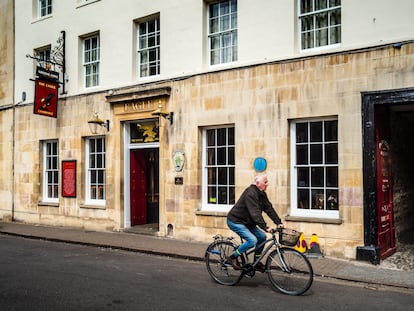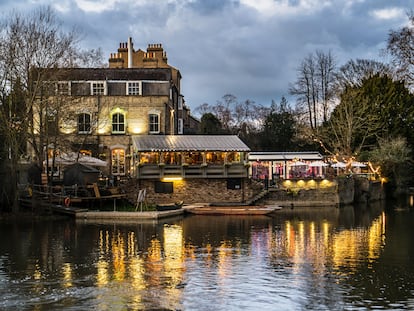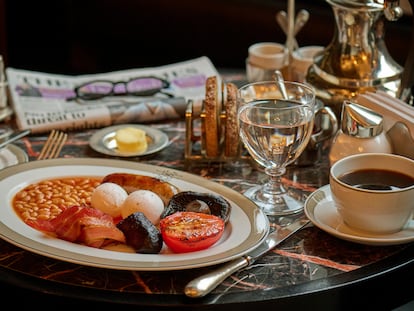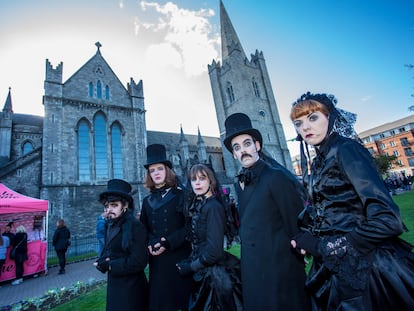A walk through Cambridge with Virginia Woolf
Visit The Orchard tea garden where her Grantchester Group met, the Girton and Newnham women’s colleges where she lectured, the Fitzwilliam Museum with her manuscripts, and a few pubs to recharge your batteries

In her autobiographical essay A Sketch of the Past (1940) Virginia Woolf describes herself emerging from a chrysalis. Rather than emphasizing its beautiful transformation, she described the vulnerability of the unprotected creature. With trembling legs and antennae, it pushes outward and emerges from the chrysalis. It waits by the broken cocoon momentarily, becoming damp with its wings still folded and its eyes dazzled, incapable of flight. This is how the British writer saw herself at the age of 13 after her mother’s death. Virginia Woolf could have settled for being a well-educated woman of the late Victorian era. Instead, her career took a decisive turn in 1928 when she went to the University of Cambridge to give lectures at two women’s colleges — Girton and Newnham. These lectures gave birth to A Room of One’s Own (1929), a book-length essay that is considered a key work of feminist literary criticism.
Apart from her famous Cambridge lectures, Woolf had other connections with the city. She often visited her aunt, Caroline Stephen, a renowned Quaker philanthropist who resided there. Although Virginia missed out on university education (which bothered her tremendously), her father, Leslie Stephen, her brothers, and her husband were all graduates of Cambridge’s famous Trinity College. She personally knew various Cambridge academics, some of whom were also members of the illustrious Bloomsbury Group of English writers, intellectuals, philosophers and artists. Woolf was also part of the Grantchester Group, which included economist John Maynard Keynes, poet Rupert Brooke, philosopher Ludwig Wittgenstein, and writer E.M. Forster, among others. They met for tea in The Orchard near Cambridge to have genteel discussions that sometimes turned into lively parties.
Our tour begins at The Orchard in Grantchester, a pleasant tea garden where you can enjoy a scone with cream and jam or relax on a lounger under the apple trees. People say that Rupert Brooke and Woolf used to go skinny-dipping at midnight in Byron’s Pool nearby. Brooke described life in Cambridge as idyllic, wandering barefoot and living on honey, eggs and milk. The Grantchester Group’s story is posted on an outdoor signboard, and The Orchard’s pavilion houses books, photos and memorabilia of the group.

Following Virginia Woolf’s trail, we head next to Girton College. Founded in 1869 as England’s first women’s college, it’s where Woolf delivered her first lecture in 1928. The building, about 10 minutes from downtown Cambridge by car, may not be as impressive as Trinity or St. Johns, but walking through the hallways is a moving experience. Photos of the first female students, dressed in long skirts to play cricket and work in the laboratory, are a jarring reminder of a different time. When Woolf arrived at Girton with her friend and lover, writer Vita Sackville-West (1892–1962), 10 years after women gained the right to vote, women were still discouraged from pursuing higher education. The room where Woolf delivered her lecture has chairs arranged in a circle and walls adorned with tapestries of birds and flora. One senses the presence of the writer with big gray eyes and melancholic look, uttering ironic and pithy observations about how men write about women, and how “a woman needs money and a room of her own if she’s going to write fiction.”
Not far away in Cambridge is Newnham College, where the writer delivered her second lecture. The gardens here are truly impressive and worth a visit. Starting with the original mid-Victorian garden and its fragrant winding paths, you’ll then discover the Arts and Crafts and rose gardens. Everything remains mostly unchanged since Woolf’s visit in 1928. For her talk to 40 students, the dining room was chosen as the venue — an expansive and bright space that is open to the public.

Just a short walk from Newnham College, near the River Cam, is The Granta pub. Although it’s unclear if Woolf ever dined there (there’s no plaque saying so), it’s a comfortable place to rest and recharge that won’t disappoint. Enjoy stunning views while savoring Scotch eggs, cauliflower in curry sauce, or chicken and leek pie.
To digest your meal, walk over to another spot that always intrigues Virginia Woolf enthusiasts and scholars. The Fitzwilliam Museum occupies a neoclassical building on Trumpington Street. Its collection includes Woolf’s manuscript of A Room of One’s Own, complete with the writer’s strike-throughs and margin notes. While it’s not on public display, the manuscript can be viewed in the University of Cambridge’s digital library. The Fitzwilliam Museum boasts diverse collections of antiquities, paintings, drawings, prints, decorative arts, numismatics, manuscripts and books. Notably, there’s a captivating post-impressionist painting by Woolf’s sister, Vanessa Stephen.

Cambridge has many attractions: romantic punt tours on the rivers, famous colleges like Trinity College, the Market Place for snacks, The Eagle pub (founded in 1525) for fish and chips, and numerous bookstores. Don’t miss the Corpus Clock, a fascinating contraption by John C. Taylor outside the Taylor Library on the corner of Bene’t and Trumpington Streets. It features a metallic insect sculpture that appears to “eat” seconds while blinking with satisfaction. Physicist Stephen Hawking inaugurated the Corpus Clock in 2008, and though Virginia Woolf never saw it, she would have loved this unique way of measuring time.

Sign up for our weekly newsletter to get more English-language news coverage from EL PAÍS USA Edition
Tu suscripción se está usando en otro dispositivo
¿Quieres añadir otro usuario a tu suscripción?
Si continúas leyendo en este dispositivo, no se podrá leer en el otro.
FlechaTu suscripción se está usando en otro dispositivo y solo puedes acceder a EL PAÍS desde un dispositivo a la vez.
Si quieres compartir tu cuenta, cambia tu suscripción a la modalidad Premium, así podrás añadir otro usuario. Cada uno accederá con su propia cuenta de email, lo que os permitirá personalizar vuestra experiencia en EL PAÍS.
¿Tienes una suscripción de empresa? Accede aquí para contratar más cuentas.
En el caso de no saber quién está usando tu cuenta, te recomendamos cambiar tu contraseña aquí.
Si decides continuar compartiendo tu cuenta, este mensaje se mostrará en tu dispositivo y en el de la otra persona que está usando tu cuenta de forma indefinida, afectando a tu experiencia de lectura. Puedes consultar aquí los términos y condiciones de la suscripción digital.










































